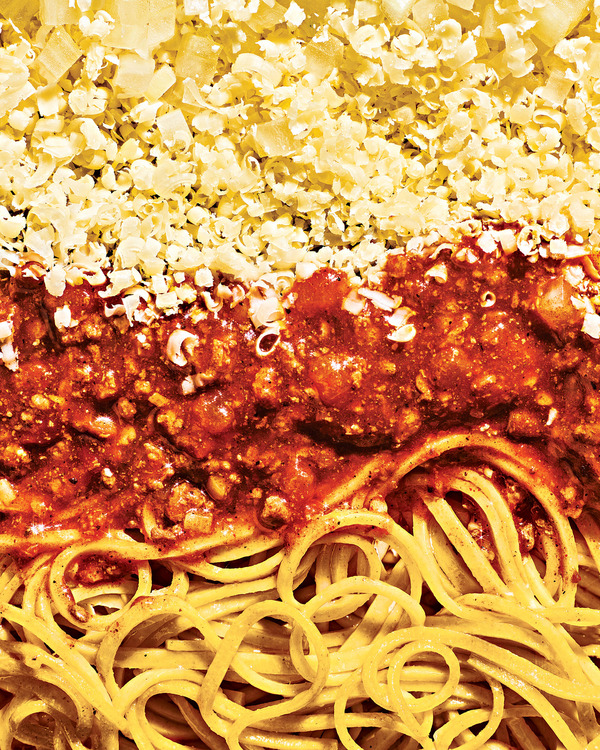When Matt Ross and Eric Finkelstein were brainstorming the menu for their new restaurant, the HiHi Room in Boerum Hill, one dish was at the top of their wish list: Cincinnati chili. Ross and Finkelstein, who have spent the past nine years tracking down and championing America’s overlooked hometown specialties at their Court Street Grocers mini-chain of sandwich shops, are natives of New Jersey and Queens, respectively, but they have a thing for Ohio’s unofficial state food; for their first table-service, full-bar, beyond-sandwiches restaurant, they wanted to do it justice. The only problem with this was that their chef, Walker Stern, a Bay Area native best known for his two former Brooklyn restaurants, Battersby and Dover, had never even heard of Cincinnati chili, and when he did, he wished he hadn’t.
The thing about Cincinnati chili, you see, is that it ain’t chili. Well, it isn’t chili as you know it but more of a soupy, Greek-style meat sauce that, in its highest form, gets sloshed atop intentionally overcooked spaghetti. On top of that goes any combination of the following: kidney beans, raw diced onion, and a boatload of shredded neon Cheddar, plus — believe it or not — oyster crackers. What really distinguishes this southern-Ohio variant from all other chili styles, though, is its seasoning: a spicy-sweet blend of cinnamon, cardamom, cumin, thyme, possibly Worcestershire, allegedly chocolate, and many other closely guarded secrets. There’s also its unique “ways” ordering system (three-way adds the cheese to the noodles and meat, four-way adds the onions or beans, five-way adds both) and its origin story, which involves a pair of Slavic-Macedonian brothers who emigrated to the United States in 1920 and converted what they had envisioned as a hot-dog topping into a dish that put Cincinnati on the regional American food map.
Incredible as it may seem, this delicious treat is not universally adored. People generally have two reactions when they first hear about Cincinnati chili. One — the one we admittedly experienced — is to begin drooling in a way that would have greatly interested the late Russian physiologist Ivan Petrovich Pavlov. The other is to recoil in horror like someone who has seen a rat heave a slice of pizza down a flight of subway stairs. Regarding Cincinnati-chili first-timers, then, there are the Droolers, and there are the Recoilers. Walker Stern, as it turns out, is a Recoiler.
But he’s also a good sport and a team player, and while soupy meat sauce plopped atop limp noodles didn’t exactly suit his fine-dining sensibilities, he was willing to give Cincinnati chili a shot. Initial recipe Googling did not go well. “Some of the recipes I saw were so insane,” says Stern. “Like cover the meat with water and bring to a boil. Who’s making this stuff?”
But then came a breakthrough: During the course of some kitchen R&D, Stern realized he could make the dish his own by melding it with a liver-and-hearts-enhanced duck Bolognese he used to cook at Battersby. The spaghetti would be fresh and hand-cut — a Cincinnati-chili first, perhaps. He’d glaze the pasta in butter, chicken stock, and Grana Padano before he sauced it. A tweak of seasonings, a couple of new garnishes (four-way, no beans) and here was a hybrid mash-up he’d call spaghetti Cincinnati to assuage the diehards.
Things were looking up, even if Stern thought his spicing wasn’t yet where it ought to be. The crowning touch arrived with a serendipitous encounter a few weeks before the HiHi Room opening, when Stern took his chef de cuisine, Marc Howard, to lunch at al di là in Park Slope for some last-minute menu brainstorming over malfatti and lemon-and-ricotta ravioli — legitimate pasta, in other words. Seated next to them were the actors John Turturro and Michael Cera, but for Stern and Howard, that wasn’t the most memorable thing about the afternoon. Fate intervened when a stranger approached their table.
“Excuse me for interrupting your lunch,” said the man, who mentioned that he was a chef at a wine bar in the East Village but whose name Stern and Howard didn’t get.
“I overheard you talking about Cincinnati chili,” he said, somewhat beside himself on account of the celebrity sightings and the chili chatter. “I just moved here from Cincinnati, and I can tell you that if you want to make true Cincinnati chili, you’ve got to get some ajwain.”
“What’s ajwain?,” asked Stern.
Ajwain, Stern was soon to learn, is a South Indian spice with a flavor reminiscent of anise and oregano that is apparently the secret to Cincinnati chili’s aromatic bouquet.
Having lucked into a hot tip, Stern probed further. “What do you think about using duck instead of beef?”
“You can’t do that,” said the stranger. “Too fancy. If anything, lamb.”
It would have been hard for anyone in this position to look upon a chance meeting like that as anything but divine intervention, and Stern is no exception. He took the stranger’s advice and tracked down some ajwain at S.O.S. Chefs in the East Village, but on the matter of the duck he stood firm. The final result, topped with a comparatively minimal amount of grated Cabot Cheddar and a modicum of onions, would probably raise eyebrows in the land of its origin, but the distinctive seasoning combined with an ingredient upgrade and an elegant balance might just make Stern’s improvisation a new New York classic.
Which brings us to a little-known addendum to the dish’s origin story. In 500 Things to Eat Before It’s Too Late, the authors and road-food scholars Jane and Michael Stern note that Tom and John Kiradjieff, the Slavic-Macedonian brothers credited with the recipe’s invention, sold hot dogs in lower Manhattan before they moved to Ohio. Apparently, the Kiradjieffs thought New York frankfurters lacked a certain tang, so they concocted a chili-sauce topping for their tube steaks, write the Sterns, implying that this was the prototype of the chili sauce they started lavishly ladling onto spaghetti in Cincinnati. Wouldn’t it be a hoot if a Bay Area native’s Brooklyn-kitchen take on an iconic Ohio dish was really a New York homecoming of sorts?











